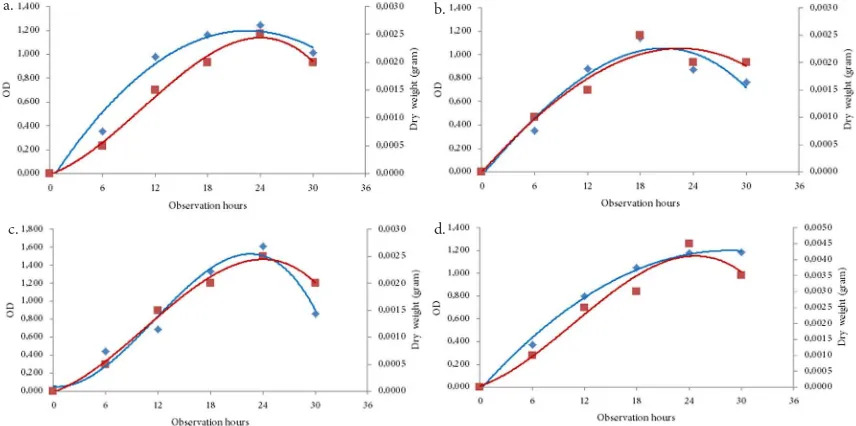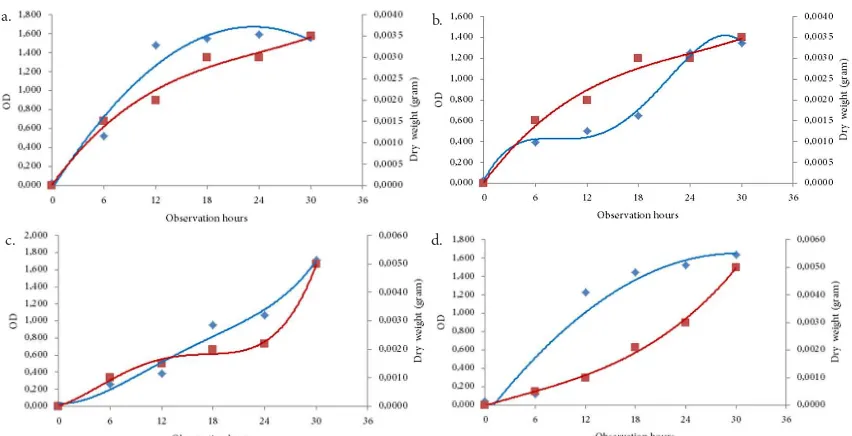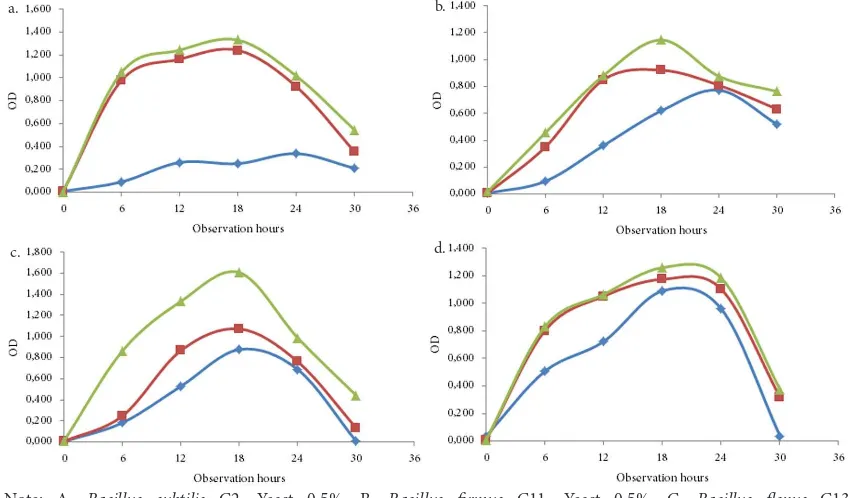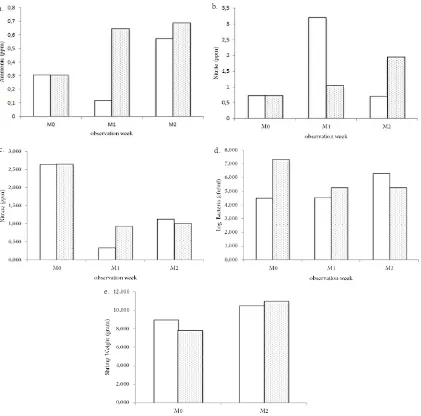Selection, Identiication and Optimization of the Growth Water Probiotic
Consortium of Mangrove Ecosystems as Bioremediation and
Biocontrol in Shrimp Ponds
Wilis Ari Setyati
*1, Erni Martani², Triyanto², Subagiyo³, Muhammad Zainuddin⁴
1) Departement of Marine Science, Faculty of Fisheries and Marine Science Diponegoro University, Post-graduate Student, Gadjah Mada University 2)Departement of Biotechnology, Post-graduate, Gadjah Mada University. ³)Marine Science Laboratory, Marine Science Departement, Diponegoro University. ⁴)Natural Product Laboratory, UPT (Integrated Laboratory), Diponegoro University.
Faculty of Fisheries and Marine – Tembalang – Semarang Telp 024 7474698 *Coresponding author: [email protected]
Accepted April 15th, 2014/Approved Agustus 10th, 2014
Abstract
Shrimp aquaculture is an activity that potentially generates organic waste. he accumulation of organic matter is becoming one of the main factors causing the emergence of disease. Problem-solving approach that is most efective is through bioremediation. he aims of this study were to select, identify and cultivate bacteria from mangrove sediments from Cilacap, Rembang and Banyuwangi which potentially as probiotic consortium of bioremediation activity and biocontrol. he results showed that total of 45 isolates (proteolytic), 35 isolates (amylolytic), 35 isolates (lipolytic), and 18 isolates (cellulolytic). here were 59 bacterial isolates had antibacterial activity of vibrio (V. harveyi, V. alginolyticus, V. vulniicus and V. anguilarum). Based on the identiication of 16 S-rRNA genes, 4 isolates showed that the C2 isolate was identiied as Bacillus subtilis, C11 isolate was identiied as Bacillus irmus, C13 and C14 isolates were identiied as B. Flexus. his study concluded that cultivation of Bacillus subtilis C2 optimum at 2% molase and yeast extract 0.5% at pH 8 and 30 0C. Bacillus irmus C11 optimum at 2% molase and yeast extract 0.5% at pH 8 and 30 0C. Bacillus lexus C13 optimum at 2% glucose and yeast extract 0.5% at pH 8 and 30 0C. Bacillus lexus C14 optimum at 4% molase and yeast extract 0.25% at pH 8 and 30 0C. he result of culture applications of 4 isolates showed an efect of increasing shrimp weight by 141, 9% compared by the control.
Keywords: sediment, mangrove, bioremediation, biocontrol
Introduction
Shrimp farm produces organic waste from the residue of the shrimp feed and feces. Jackson’s studies (2003) showed that the nitrogen eiciency usage of feed was approximately 22%, whereas 78% of nitrogen was discharged into the environment and accumulated in the bottom of sediment pond. High organic matters content will spur on the growth of microorganisms, biodecomposition process and oxygen consumption (Avnimelech and Ritvo 2003). Insuicient oxygen conditions triggers the growth of anaerobic microorganisms which actively reducing SO42- into H
2S that
inhibited the growth of domestic animals (Mugnier et al. 2008). It is necessary to attempt to overcome the accumulation of organic matter in
the sediment pond. he most efective approach is through bioremediation (microorganism’s agent). Organic waste of feed are complex, so that, bioremediation requires a consortium of diferent microorganisms with the kind of variation of activity to clean up organic matter.
the procedure according to Jacob & Gerstein (1960) in Bairagi et al. (2002) which used 2216 E Zobell agar medium enriched with starch (1%). Lugol’s iodine solution is poured above 1% of bacteria for agar identiication of amylolytic activity (clear zone was formed). Cellulolytic activity test was performed using agar medium enriched with 1% CMC. Congo red solution was poured into the bacteria for identiication of cellulose hydrolysis activity. Lipolytic activity test was done according to the procedure Sangiliyi and Gunasekeran
(1996) in Bairagi et al. (2002) which used 2216
E Zobel agar medium enriched with 80 tween. Lipase activity was shown by the formation of fatty acid deposits around the bacteria.
Bacterial Selection Based on Antibacterial Capability
Antibacterial test for all isolates against
pathogens (V. alginoliticus, V. harveyi,
V. anguilarum and V. vulnivicus ) were performed by puncturing technique and overlaying (Isnansetyo 2004). the pure isolate cultures were inserted on the 2216 E Zobell agar medium by using a needle preparation and were incubated for 24 hours. Ater 24 hours of incubation, the overlay was done by pouring the pathogen into Zobell 2216 E sot agar medium (70%). Double layered then were incubated for 24 hours. Antagonist activity was identiied by the production of clear zone without growth (inhibition zone) around the puncture of colony.
Antagonist Test Between Isolates
Antagonist tests were conducted using streak on Zobell agar medium. Antagonist activity was shown by the clear zone/barrier zone around the colony.
Identiication of Bacteria Consortium by
16s-rrna Gene Molecular
he ampliication of 16S-rRNA gene was performed by using 1 mL of DNA template were ampliied by PCR Beads kit RTG using a universal primer (Marchesi et al. 1998), there were 63F
Materials and Methods
he study was conducted by the laboratory experimental method and design of complete randomized study. Overall, the study will be carried in 5 stages: isolations, selections, identiications, cultivations and applications. Insulating phase consists of the preparation, dilution and puriication. Selection phase consists of selection of proteolytic activity, amylolytic, cellulolytic, lipolytic, antibacterial and antaginis. Phase of identiication of the molecular basis of bacterial consortium-based on 16S rRNA gene. Cultivation phase of probiotic consortium consists of 4 phases: screening and selecting of probiotic growth nutrients, optimization the nutrient concentrations of growth, optimization the pH growth, and optimization the growth temperature. Consortium Application phase was conducted on a bench scale (bench scale).
Isolation of Bacteria
Sediment sampling was performed on mangrove area in Cilacap, Rembang and Banyuwangi. Sediment samples were taken using a soil sampler at a depth of +10 cm. he Sediment samples were diluted up to 10-5, 10-6 and 10-7, respectively inoculation performed by pour plate method. Furthermore petri dishes were incubated for 2 x 24 hours. he colonies of bacteri which were formed on each petri dish from each dilution were isolated that showed diferent morphology. Isolation and puriication of bacterial isolates were performed by the method of scratches (streak method).
Bacteria Based Selection Capability Doing
Biodegradation of Organic Materials
Screening will be done for bacteria that are capable of altering or degrading polysaccharides, proteins and fats by the approaching the activity of protease enzymes, amylase, cellulase and lipase. Tests were carried out by the procedure of proteolytic activity by Jacob & Gerstein (1960) within Bairagi et al. (2002) by using 2216 E Zobell medium enriched with skim milk (1%).
(5’-CAGGCCTAACACATGCAAGTC) and 1387r (5’-GGGCGGWGTGTACAAGGC). It was made a master mix containing 1.5 units of Tag DNA polymerase, 10 mM Tris HCl (pH 9.0 at room temperature), 50 mM KCl, 1.5 mM MgCl2, 200 mM on each dNTP and a stabilizer and including BSA and 1 mL of DNA template. hen, put into a PCR machine, GeneAmp PCR Systems 2400 (Perkin Elmer Biosystems, USA), with the Pre-PCR conditions (94°C, 2 minutes), denaturation (92°C, 30 seconds), primer annealing (55°C, 30 seconds ), elongation (75°C, 1 min) and a Post PCR (75°C, 5 min), the cycle 30 times. he results of 16S-rRNA gene ampliication which produced the positif results were followed on positive sequencing analysis. Homology analysis was done by online at http:// www.ddbj.nig.ac.jp/.
Screening and Selecting of Nutrient Growth
he methods used in this study followed the procedure according to Polak-Bereka et al. (2010) and Sathyanarayanan et al. (2011). hree carbon sources is glucose, fructose, and molasses, also three nitrogen sources peptone, yeast extract and urea at a concentration of 1% will be screened according to the production of biomass. All of the media were adjusted to pH 6.0. Medium were inoculated by starter isolates that gave OD 0.01 on the A600. Incubation at room temperature, every 6 hours for 30 hours intervals, samples were taken as many as 4 mL then measuring the OD at A600.
Screening and Selecting of Nutrient
hree concentrations of carbon sources were 1%, 2% and 4%, and three concentrations of nitrogen sources were 0.25%, 0.5% and 1.0%. Medium was inoculated with starter isolates that gave OD 0.01 on the A600. Incubation at room temperature and at intervals of 6 hours for 30 hours samples were taken at 7 mL. then it were measured for the OD at A600 and the dry weight of the bacteria.
Optimizing of pH
Medium with carbon sources and
nitrogen sources with the optimum concentration was adjusted to pH variation of 6, 7 and 8 then were inoculated with a starter isolates that gave OD 0.01 on A600 and incubation at room temperature. Each 12-hour intervals for 60 hours samples were taken by 10 mL, then measuring the OD at A600.
Optimizing of Temperature
Medium was added with a carbon sources and a nitrogen sources at the optimum concentration. It were inoculated with a starter isolates that gave OD 0.01 on the A600. Incubation at varied temperature 30, 34 and 38 0C. every 12-hour intervals for 60 hours samples were taken by 7 mL then were
performed measuring OD at A600.
Tests of Consortium Application
he application consortium tests at the laboratory scale using a plastic tub, sea water and soil sediment pond which was dried at a thickness about 10 cm. Each test basins used aeration system and the shrimps (tokolan) were spreaded at a density of 12 shrimps tails / 50 liters of water. Feeding was done 3 times a day with the amount of 5% of the total weight of shrimp were stocked. Observations were
and isolates C-13 and C-14 were identiied as Bacillus lexus. Bacteria were gram-positive bacillus, rod-shaped, endospores form was resistant to high temperature, low temperature, radiation, drying and disinfectants, aerobic or facultative anaerobic (Turnbull, 1996). Bacteria of the genus Bacillus has been widely used and developed as an agent to decompose organic material and pathogen control. he capability of Bacillus bacteria to produce antibacterial compounds were carried out by Vaseeharan and Ramaswamy (2003) who tested the BT application of Bacillus subtilis 23 to control vibrio bacteria in shrimp farming.
he result of the selection of carbon and nitrogen sources for the production of probiotic bacteria was shown in Table 1 and Table 2. Based on the analysis of the growth rate (Table 1) showed that the C2 Bacillus subtilis, Bacillus irmus C11, and Bacillus he results of Antagonist activity test
among isolates obtained 9 isolates that produced extracellular enzymes and 5 isolates which actively inhibiting bacteria vibrio that each other were not antagonistic. Based on the capabilities of multi activities which are non-antagonistic to each other were obtained total of 4 potential isolates to be developed as a consortium, C-02, C-11, C-13 and C-14. Some researchers showed that bacteria heterotrophic in mangrove ecosystem was the main source of extracellular enzymes that was necessary for mineralization of organic material which produces enzymes including amylases, proteases, esterases and lipases (Dias et al. 2009).
he results based on the identiication of 16 S-rRNA genes indicated that the C-02 isolates were identiied as Bacillus subtilis.
C-11 isolates were identiied as Bacillus irmus
Table 1 he growth rate of probiotic bacteria on diferent carbon source media treatment
Isolates Growth Rate of Bacteria (OD/hours)
Fructose Glucose Molase
Bacillus subtilis C2 0.037±0.0014a 0.047±0.0063b 0.050±0.0048b
Bacillus irmus C11 0.040±0.0013a 0.049±0.0057b 0.052±0.0052b
Bacillus lexus C13 0.014±0.0017a 0.049±0.0010c 0.046±0.0008b
Bacillus lexus C14 0.043 ±0.0091a 0,046±0.0076a 0.053±0.0063a
Note: he average of ± standard deviation, Italic letters on the same value in the same row are not signiicantly diferent at p>0.05.
Figure 1 he number of isolates bacteria which have enzymatic and antibacterial activity
Note: No: Number of isolates; P: Proteolytic, A: Amilolytic, L: Lipolytic, S: Selulolytic, Vh: V. harveyi, Val: V. alginolyticus, Vv: V. vulniicus, Van: V. anguilarum. Rembang, Cilacap, Banyuwangi
enzymatic and antibacterial activity
b
ac
ter
ia i
so
la
lexus C14 have a high growth rate on 1% molasses respectively the rate of change in
OD/hour at 0,050±0,0048b, 0.052±0,0052b,
and 0.053±0,0063a. While Bacillus lexus C13
had the highest growth rate at addition of 1% glucose is 0.049±0,0010c.
he high growth in Zobell liquid medium which was enriched with molasses was occurred due to the molasses as carbon source as well as sources of minor vitamin and nutrients that can be used as a growth factor
(Kulpreecha et al. 2005). he low capability of
Bacillus lexus C13 to use molasses indicated that C13 strains had diferent physiological
characteristics, primarily related to the ability to produce extracellular enzymes which was needed to break down complex organic carbon such as molasses. Glucose is a simple sugar that is available to be directly used for bacteria.
Based on the analysis of growth rate (Table 2) showed that the best source of nitrogen as a co-substrate to increase the growth rate of those 4 bacteria was yeast extract. It might be possible because of yeast extract had advantages over other nitrogen sources. It was In line with research Peighamy-Ashnaei et al. (2007) that yeast extract was
Table 4 he growth of probiotic bacteria on optimized nitrogen sources media treatment
Isolates Concentration of Yeast Source at pH 8
0.25% 0.5% 1%
Bacillus subtilis C2 0.0300±0.0087b 0.0368±0.0004b 0.0061±0.0004b
Bacillus irmus C11 0.0162±0.0033a 0.0256±0.0001b 0.0153±0.0020b
Bacillus lexus C13 0.0232±0.0037a 0.0294±0.0023b 0.0204±0.0020a
Bacillus lexus C14 0.0344 ±0.0010b 0,0230±0.0055a 0.0242±0.0018a
Note: he average of ± standard deviation, Italic letters on the same value in the same row are not signiicantly diferent at p>0.05.
Table 2 he growth rate of probiotic bacteria on diferent nitrogen source media treatment
Isolates Growth Rate of Bacteria (OD/hours)
Pepton Yeast extract Urea
Bacillus subtilis C2 0.018±0.0018b 0.024±0.0020cc 0.005±0.0003a
Bacillus irmus C11 0.032±0.0021b 0.036±0.0080b 0.013±0.0033a
Bacillus lexus C13 0.033±0.0075b 0.045±0.0010c 0.017±0.0035a
Bacillus lexus C14 0.025±0.0018a 0,041±0.0053b 0.022±0.0014a
Note: he average of ± standard deviation, Italic letters on the same value in the same row are not signiicantly diferent at p>0.05.
Table 3 he growth of probiotic bacteria on optimized carbon sources media treatment
Isolates Nutrition Growth Rate of Bacteria (OD/hours)
1% 2% 4%
Bacillus subtilis C2 Molase 0.0171±0.0024a 0.0341±0.0043c 0.0313±0.0088b
Bacillus irmus C11 Molase 0.0154±0.0013a 0.0218±0.0044b 0.0142±0.0002a
Bacillus lexus C13 Glucose 0.0141±0.0001a 0.0312±0.0010b 0.0252±0.0002b
Bacillus lexus C14 Molase 0.0189±0.0002a 0,0284±0.0041b 0.0324±0.0067b
a good source of nitrogen for the growth of
most Bacillus subtilis compared with urea and
malt extract (Figure 2).
Based on the results of carbon source screening, that followed by optimization of concentration (Table 3). Results of optimization of the concentration of carbon source (glucose and molasses) showed that the optimum concentration of glucose were added to cultures of Bacillus lexus C13 was the concentration of 2%, whereas the optimum concentration of molasses which were added to the culture C2 Bacillus subtilis, and Bacillus irmus C11 were 2 %, and Bacillus lexus C14 was 4% (Figure 3).
he results above indicated that diferent bacterial strains had an optimum concentration for diferent source (molasses). he results of the study Magdi et al. (2010) obtained diferent results with this research that molasses concentration optimal for growth of Bacillus subtilis KO was 10%. his suggests that diferent bacterial strains had an optimum concentration for diferent. C source (molasses).
Based on the results of nitrogen source screening, that followed by optimization of nitrogen source concentration. he Results of optimization of the concentration of the nitrogen source (yeast extract) (Table 4) Table 5 he growth of probiotic bacteria on optimum carbon sources
and pH with temparature media treatment
Isolates Carbon Source with a Temeprature (°C)
30 34 38
Bacillus subtilis C2 0.2898±0.0055c 0.2350±0.0018a 0.2630±0.0026b
Bacillus irmus C11 0.2148±0.0010c 0.1878±0.0019b 0.1694±0.0018a
Bacillus lexus C13 0.2937±0.0055c 0.2820±0.0026a 0.2223±0.0018b
Bacillus lexus C14 0.4157 ±0.0016c 0,2537±0.0021a 0.3925±0.0049b
Note: he average of ± standard deviation, Italic letters on the same value in the same row are not signiicantly diferent at p>0.05.
Figure 2 OD and Dry weight of bacteria on optimum nitrogen sources concentration media
a. b.
c. d.
were occurred at a concentration of 0.5% except Bacillus lexus C14 was occurred at a concentration of 0.25%.
he results of the study Magdi et al.
(2010) obtained diferent results with this research that molasses concentration optimal
for growth of Bacillus subtilis KO was10%.
Based on the pH optimization results obtained optimum pH for the growth of all four types of bacteria on Zobell liquid medium with the addition of a source of C and N at the optimal concentration was 8 (Figure 4 and 5). It indicated that all four types of bacteria were classiied to bacteria alkalophilic.
Alkalophilic Bacteria were
microorganisms that lived well at alkaline pH
(above pH 7). Results of research conducted by Magdi et al. (2010) in Bacillus subtilis KO obtained optimum pH of 6.5 - 7 pH. he Optimization results for Bacillus irmus was carried out by Roosdiana et al. (2013) that obtained an optimum pH value of 7-8. pH, it was in line with the results of this research.
Other environmental factor that greatly afects the rate of bacterial growth was temperature. Temperature had efect on the stability of the functional molecular structure especially the enzyme. Enzyme was catalysts of metabolic reactions. Results of optimization of cultivation temperature for the four types of bacteria in Zobell liquid medium with the addition of a carbon source (molasses and
Table 6 he growth of probiotic bacteria on optimum nitrogen sources and pH media with temparature optimization treatment
Isolates Carbon Source with a Temeprature (°C)
30 34 38
Bacillus subtilis C2 0.2868±0.0028c 0.0917±0.0013a 0.1918±0.0011b
Bacillus irmus C11 0.2025±0.0019c 0.1676±0.0039b 0.1216±0.0012a
Bacillus lexus C13 0.2480±0.0044b 0.2375±0.0017a 0.3120±0.0016b
Bacillus lexus C14 0.3806±0.0012c 0,2014±0.0014a 0.2615±0.0068b
Note: he average of ± standard deviation, Italic letters on the same value in the same row are not signiicantly diferent at p>0.05.
Figure 3 OD and dry weight of bacteria on optimum carbon source concentration media
d.
a. b.
c.
Figure 4 OD bacteria at optimum carbon source media optimization ph treatment
b.
d. a.
c.
Note: A. Bacillus subtilis C2, Molase 2%. B. Bacillus irmus C11, Molase 2%. C. Bacillus lexus C13, Glucose 2%. D. Bacillus lexus C14, Molase 4%. : pH 6, : pH 7, : pH 8
Figure 5 OD bacteria at optimum nitrogen source media optimization ph treatment
a. b.
d. c.
Note: A. Bacillus subtilis C2, Yeast 0.5%. B. Bacillus irmus C11, Yeast 0.5%. C. Bacillus lexus C13, Yeast 0.5%. D. Bacillus lexus C14, Yeast 0.25%. : pH 6, : pH 7, : pH 8
glucose) and nitrogen source (yeast extract) were shown in Table 5 and Table 6.
he result of the growth analysis showed that all four types of bacteria grew optimally at 30°C. Bacteria that lived optimally
(2012) that the optimum temperature for
growth of Bacillus lexus FPB17 was 35°C. he
diference in the optimum temperature for Bacillus irmus might occur due to diferent strains.
he results of analysis of ammonia, nitrite, nitrate and total bacteria in Water Medium with Probiotic Applications Treatment were shown in Figure 6. he Results showed an increase of ammonia during the research. Ammonia is a product of nitriication of
nitrogenous organic material by bacteria and excretion activity by shrimps. According Hovanec and De Long (1996), the types of nitrifying bacteria include: the group of ammonia-oxidizing bacteria that consisting
of Nitrosomonas europaea, Nitrosococcus
mobilis, Nitrosolobus multiformis; he group
of nitrite-oxidizing bacteria consisted
Nitrobacter winogradskyi, Nitrobacter agilis, Nitrococcus mobilis. he pattern changes of ammonia, nitrite and nitrate in this tests Figure 6 Analysis of ammonia, nitrite, nitrate and total bacteria in Water Medium with Probiotic
Applications Treatment
a. b.
d.
e. c.
showed that the high nitriication process on treatment, the oxidation process from ammonia to nitrite was low and the process of oxidation from nitrite to nitrate was high.
Probiotic consortium application showed the changes of microbiological community. Isolates 13 and isolates 14 were isolates that having antagonistic activity against Vibrio bacteria. So the existence of these two isolates causing changes bacteriological community. his change brought a positive efect on shrimp growth. his was indicated by the efect of increasing the weight of shrimp in the application of probiotic, which caused an increase compared to the control. Antagonistic activity by consortium members against pathogenic bacteria, especially bacteria vibrio might be possible to control the presence of harmful bacteria.
Conclusion
he results of this study showed a total of 44 isolates having proteolytic activity, 35 isolates had amylolytic activity, 35 isolates had lipolytic activity, and 18 isolates had cellulolytic activity of, 12 isolates of nitrifying bacteria, and 59 isolates of bacteria that have antagonistic activity against Vibrio bacteria. he results of this study concluded that there were 4 selected isolates from selection of bacteria isolates. Bacillus subtilis C-02, C-11, Bacillus irmus, Bacillus lexus C-13 and C-14 Bacillus lexus were potential to be developed as consortium of probiotic for shrimp farming because of their non-antagonostic to each
had optimum at 4% molasses carbon sources and yeast extract nitrogen sources 0.25% at pH 8 and temperature 30°C. he result of culture applications of these 4 isolates showed an efect
of increasing shrimp weight achieved by the control. Water quality analysis indicated levels of ammonia, nitrite and nitrate tended to be higher in the treatment than in the control.
References
Avnimelech Y, and G. Ritvo. 2003. Shrimp and ish pond soils: processes and management. Aquaculture 220:549-567.
Atlas, RM. Bartha, R. (1998): Microbial Ecology, Fundamental and Applications. he Benjamin/Cumming Publ. Co. California. Bairagi A, Ghosh K, Kumarsen S, Ray A
K. 2002. Enzyme producing bacterial lora isolated from ish digestive tracts. Aquaculture International 10 : 109-121. Dias ACF, Andreote FD, Dini-Andreote F,
Lacava PT, Sa ALB, Melo IS, Azevedo JL, Arau´ jo WL. 2009. Diversity and biotechnological potential of culturable
bacteria from Brazilian mangrove
sediment. World Journal Microbiol
Biotechnology 25:1305–1311.
Falguni PR, and Sharma MC. 2012. Optimizatio of Production of Alkali Phosphatase by a Facultative Alkaliphile Bacillus lexus FPB 17 Isolated from Alkaline Lake
Soils. Journal of Agriculture Technology
8(5):1605–1612.
Hovanec TA, and DeLong EF. 1996. Comparative Analysis of Nitrifying Bacteria Associated with Freshwater and Marine Aquaria. Applied and Environmental Microbiology 62(8):2888-2896.
Isnansetyo A. 2004. Bakteri Antagonis sebagai Probiotik Untuk Pengendalian Hayati
Pada Akuakultur. Jurnal Perikanan 1: 1-10.
Isnansetyo A. 2004. Uji Antagonistik Langsung, Suatu Metode Baru Skrining Bakteri Penghasil Antibiotik dan Penerapannya Untuk Skrining Probiotik. Prosiding Seminar Nasional Penyakit Ikan dan Udang, Univeritas Jendral Soedirman, Purwokerto.
Shrimp Farm. Aquaculture 218:397–411.
Kulpreecha S, Boonruangthavorn A,
Meksiriporn B, and hongchul N. 2009. Inexpensive fed-batch cultivation for high poly (3-hydroxybutyrate) production by a new isolate of Bacillus megaterium. Journal of Bioscience and Bioengineering 107(3):240-245.
Magdi AMY, Francis FH, Moustafa AN and Mohamed SAS. 2010. Optimization of Cultivation Medium and Growth Conditions for Bacillus subtilis KO Strain Isolated from Sugar Cane Molasses. America–Eurasian Journal Agriculture & Environment Science 7(1):31–37.
Mugnier C, Zipper E, Goartant C, and Lemonnier H. 2008. Combined efect of exposure to ammonia and hypoxia on the blue shrimp Litopenaeus stylirostris survival and physiological response in relation to
molt stage. Aquaculture 274:398-40.
Peighamy-Ashnaei S, Sharii-Tehrani A, Ahmadzadeh M, and Behboudi K. 2007. Efect of carbon and nitrogen sources
on growth and biological eicacy of
Pseudomonas luorescens and Bacillus
subtilis against Rhizoctonia solani, the causal agent of bean damping-of.
Commun, Agriculture Applied Biology
Science 72(4):951-6.
Roosdiana A, Prasetya S, Mahdi C, Sutrisno. 2013. Production and Characterization of Bacillus irmus Pectinase. Journal Pure Applied Chemistry Resource 2(1):35-41. Smith D, Davey S. 1993. Evidence for he
Competitive Exclusion of Aeromonas
salmenicida From Fish With
Stress-Inducible Furrunculosis by A Flourescent Pseudomonas. Journal of Fish Deseases 16:521-524.
Turnbull PCB. 1996. Bacillus, Medical Microbiology. 4th edition. Baron S, editor., Galveston (TX): University of Texas Medical Branch at Galveston.
Vaseeharan B, Ramasamy P. 2003. Control of pathogenic Vibrio spp. by Bacillus subtilis BT23, a possible probiotic treatment for
black tiger shrimp Penaeus monodon. Lett





